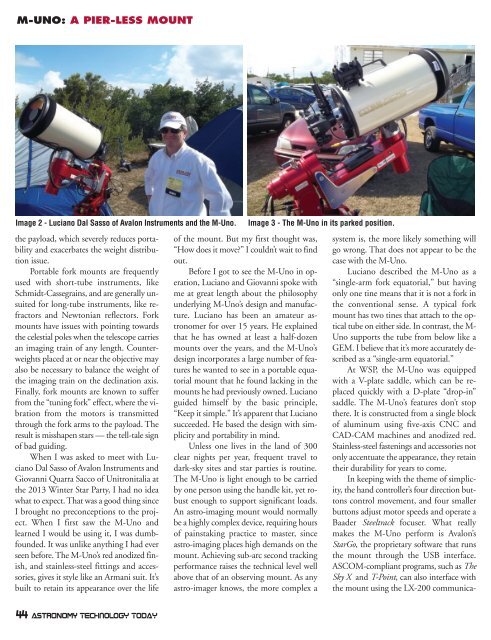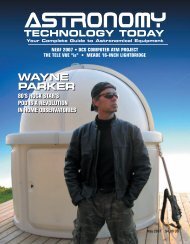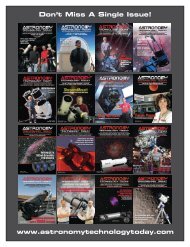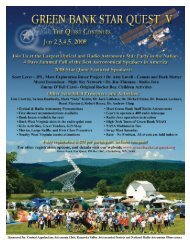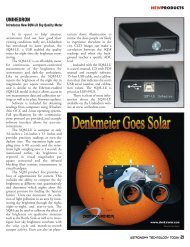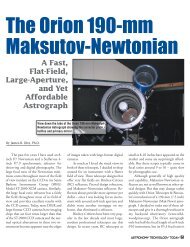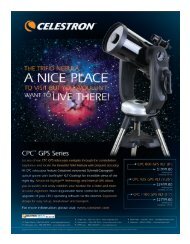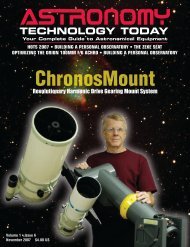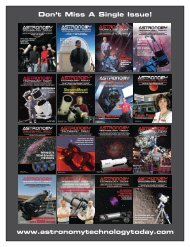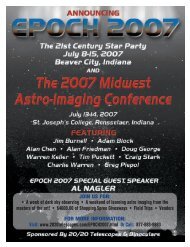iOPTRON - Astronomy Technology Today
iOPTRON - Astronomy Technology Today
iOPTRON - Astronomy Technology Today
You also want an ePaper? Increase the reach of your titles
YUMPU automatically turns print PDFs into web optimized ePapers that Google loves.
M-UNO: A PIER-LESS MOUNT<br />
Image 2 - Luciano Dal Sasso of Avalon Instruments and the M-Uno.<br />
the payload, which severely reduces portability<br />
and exacerbates the weight distribution<br />
issue.<br />
Portable fork mounts are frequently<br />
used with short-tube instruments, like<br />
Schmidt-Cassegrains, and are generally unsuited<br />
for long-tube instruments, like refractors<br />
and Newtonian reflectors. Fork<br />
mounts have issues with pointing towards<br />
the celestial poles when the telescope carries<br />
an imaging train of any length. Counterweights<br />
placed at or near the objective may<br />
also be necessary to balance the weight of<br />
the imaging train on the declination axis.<br />
Finally, fork mounts are known to suffer<br />
from the “tuning fork” effect, where the vibration<br />
from the motors is transmitted<br />
through the fork arms to the payload. The<br />
result is misshapen stars — the tell-tale sign<br />
of bad guiding.<br />
When I was asked to meet with Luciano<br />
Dal Sasso of Avalon Instruments and<br />
Giovanni Quarra Sacco of Unitronitalia at<br />
the 2013 Winter Star Party, I had no idea<br />
what to expect. That was a good thing since<br />
I brought no preconceptions to the project.<br />
When I first saw the M-Uno and<br />
learned I would be using it, I was dumbfounded.<br />
It was unlike anything I had ever<br />
seen before. The M-Uno’s red anodized finish,<br />
and stainless-steel fittings and accessories,<br />
gives it style like an Armani suit. It’s<br />
built to retain its appearance over the life<br />
of the mount. But my first thought was,<br />
“How does it move?” I couldn’t wait to find<br />
out.<br />
Before I got to see the M-Uno in operation,<br />
Luciano and Giovanni spoke with<br />
me at great length about the philosophy<br />
underlying M-Uno’s design and manufacture.<br />
Luciano has been an amateur astronomer<br />
for over 15 years. He explained<br />
that he has owned at least a half-dozen<br />
mounts over the years, and the M-Uno’s<br />
design incorporates a large number of features<br />
he wanted to see in a portable equatorial<br />
mount that he found lacking in the<br />
mounts he had previously owned. Luciano<br />
guided himself by the basic principle,<br />
“Keep it simple.” It’s apparent that Luciano<br />
succeeded. He based the design with simplicity<br />
and portability in mind.<br />
Unless one lives in the land of 300<br />
clear nights per year, frequent travel to<br />
dark-sky sites and star parties is routine.<br />
The M-Uno is light enough to be carried<br />
by one person using the handle kit, yet robust<br />
enough to support significant loads.<br />
An astro-imaging mount would normally<br />
be a highly complex device, requiring hours<br />
of painstaking practice to master, since<br />
astro-imaging places high demands on the<br />
mount. Achieving sub-arc second tracking<br />
performance raises the technical level well<br />
above that of an observing mount. As any<br />
astro-imager knows, the more complex a<br />
Image 3 - The M-Uno in its parked position.<br />
system is, the more likely something will<br />
go wrong. That does not appear to be the<br />
case with the M-Uno.<br />
Luciano described the M-Uno as a<br />
“single-arm fork equatorial,” but having<br />
only one tine means that it is not a fork in<br />
the conventional sense. A typical fork<br />
mount has two tines that attach to the optical<br />
tube on either side. In contrast, the M-<br />
Uno supports the tube from below like a<br />
GEM. I believe that it’s more accurately described<br />
as a “single-arm equatorial.”<br />
At WSP, the M-Uno was equipped<br />
with a V-plate saddle, which can be replaced<br />
quickly with a D-plate “drop-in”<br />
saddle. The M-Uno’s features don’t stop<br />
there. It is constructed from a single block<br />
of aluminum using five-axis CNC and<br />
CAD-CAM machines and anodized red.<br />
Stainless-steel fastenings and accessories not<br />
only accentuate the appearance, they retain<br />
their durability for years to come.<br />
In keeping with the theme of simplicity,<br />
the hand controller’s four direction buttons<br />
control movement, and four smaller<br />
buttons adjust motor speeds and operate a<br />
Baader Steeltrack focuser. What really<br />
makes the M-Uno perform is Avalon’s<br />
StarGo, the proprietary software that runs<br />
the mount through the USB interface.<br />
ASCOM-compliant programs, such as The<br />
Sky X and T-Point, can also interface with<br />
the mount using the LX-200 communica-<br />
44 <strong>Astronomy</strong> TECHNOLOGY TODAY


